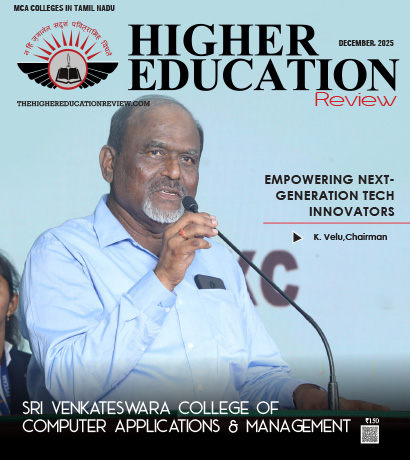Organizational Culture: The Cornerstone of a Company's Every People Strategy
 In a recent interaction with Higher Education Review, Amrita Tewari shared her insights on various aspects such as the impact the organizational culture has on the company’s decision-making process and more.
In a recent interaction with Higher Education Review, Amrita Tewari shared her insights on various aspects such as the impact the organizational culture has on the company’s decision-making process and more.
After earning her Executive Diploma in Human Resource Management from XLRI Jamshedpur, Amrita joined Strategic Systems in 2022. Before that, she gained valuable experience in various HR roles at Apollo Health & Lifestyle, US Tech Solutions, and Hamstech College of Creative Education. In addition to her HR expertise, Amrita is a founding member of Niryati Global SCM, a 4PL Global Supply Chain company.
What impact does organizational culture have on the company’s decision-making processes?
In the current business landscape, the role of organizational culture cannot be overstated. It profoundly influences various facets of a company, including how employees respond to challenges, their perceptions of business leadership, and the overall direction in which the company is heading. Consequently, it is imperative for HR leaders to establish the right foundational principles when it comes to shaping the culture. While the leadership team bears the primary responsibility for this endeavour, it's essential to understand that cultivating an organizational culture is not a task achievable overnight, nor is it the sole responsibility of any one individual. In essence, building an organizational culture is akin to the accumulation of countless small actions and reactions over time.
Consider this scenario: when an employee tenders their resignation, there can be many reasons behind their decision. In this situation, the initial step should not originate from the HR team but rather from the immediate reporting Team Leader or Manager. They should engage in a conversation with the departing employee, seeking feedback on their overall experience with the company and understanding the reasons that led to their decision to leave. Likewise, gathering input from new hires about their initial day at the organization is a crucial aspect of nurturing the organizational culture, contributing to an improved employee experience.
How can business leaders effectively integrate diversity and inclusion into the organization’s culture?
In today's corporate landscape, achieving diversity and inclusion is a shared goal for every organization. We envision our companies as safe havens where individuals of all genders can thrive in their professional journeys. However, the path to achieving this vision has proven successful for only a select few organizations. While many multinational corporations are taking significant steps in transgender hiring, there are certain crucial aspects they must consider to support their employees effectively. Business leaders, in particular, need to focus on two key factors. Firstly, they must ensure that bias has no place in our workplaces, fostering an environment where every individual is treated with fairness and respect. Secondly, normalizing the transgender concept across all stakeholders is vital, making it an integral part of our corporate culture. Given the absence of well-defined statutory guidelines in our country for hiring diversified talent, business leaders should take a proactive approach by engaging in constructive dialogue with regulatory bodies to establish comprehensive guidelines for this matter. However, the most significant responsibility lies with the management team. It is our duty to thoroughly educate our existing workforce about diversity and inclusion before introducing any new programs or initiatives aimed at enhancing diversity and inclusion throughout the organization. To sum it up, our leadership team holds a paramount role in ensuring that diversity and inclusion become an integral part of our organizational DNA.
Briefly explain the importance of an organization aligning its mission & vision statements with its culture and values.
In the corporate world, we often hear about the essential triad of 'mission,' 'vision,' and 'values.' The mission is what a company aims to achieve in the short term, while the vision is the long-term goal or objective. However, it's the values that serve as the bedrock on which both the mission and vision stand.
Values are like guiding stars, helping us navigate crucial decisions, determining the right course of action, and outlining how we treat our employees, among other things. Since the mission and vision originate from the core values a company embraces and practices, they are intrinsically linked. It's a symbiotic relationship, and if a company's mission and vision are not aligned with its values, it risks compromising its very foundation.
In light of this, it becomes clear that values should permeate every facet and function of an organization. They are not just words on a wall or a statement in a handbook. Values are the compass that keeps us on course and ensures our journey is not only successful but also meaningful and ethical.
Suggest a few steps business leaders must undertake to foster a culture of innovation and continuous learning in their organization.
You know, creating a workplace where everyone is encouraged to come up with new ideas and keep on learning is all about how much a company supports its employees. When a company values its team, it invests in helping them learn new things, gain skills, and be more competitive in the job market. This means spending money on training and development.
However some companies, see employees as a cost, and their main focus is to cut expenses. This approach can stop new ideas and block chances for people to learn and grow. Sadly, many companies end up in this situation.
The critical role of leadership and Human Resources cannot be overstated in this context. It's the leaders' responsibility to conceive and implement initiatives that foster innovation and learning. Vision and mission statements should reflect a commitment to nurturing a culture where continuous improvement and innovation are not just buzzwords, but the beating heart of the organization.

